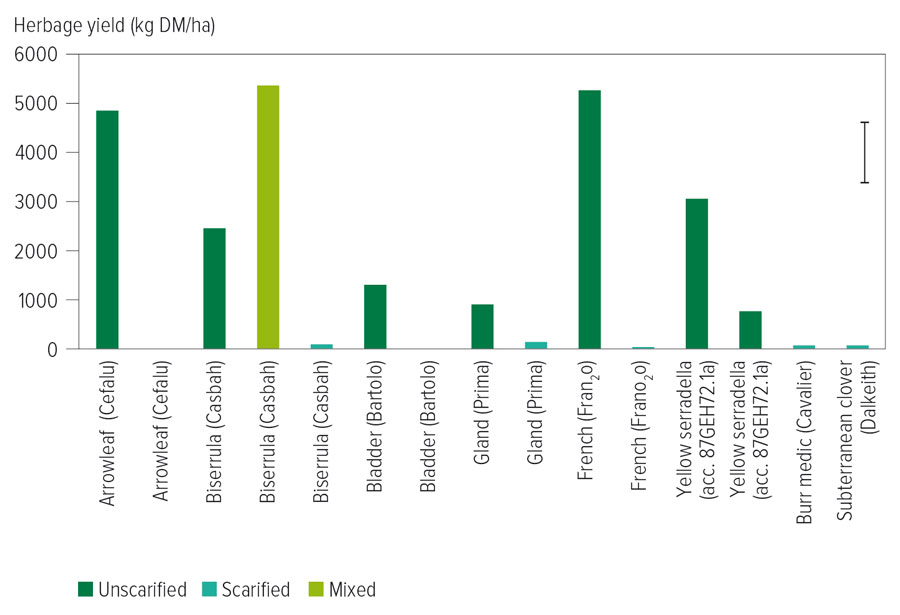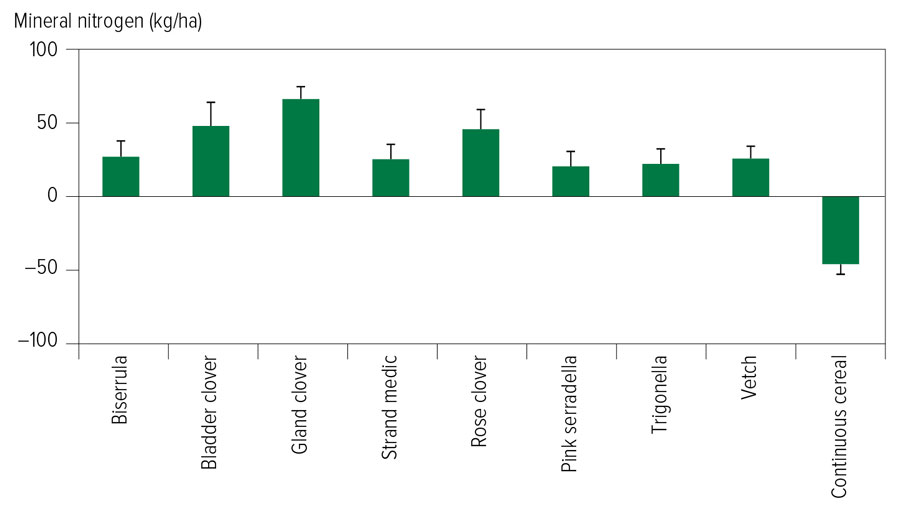Key points
- Choosing annual pasture legume species adapted to regional conditions and optimising their establishment can make integrating pasture phases into cropping sequences more economic and effective in low-rainfall environments
- Two new pasture legumes adapted to low-rainfall mixed-farming regions are scheduled for release in 2021, with more to follow
Optimising nitrogen-fixing annual legume growth in rotations can reduce the subsequent crops’ reliance on synthetic fertilisers and buffer against seasonal conditions and commodity price uncertainties.
With investment from GRDC, the Department of Agriculture and Water Resources, Australian Wool Innovation and Meat & Livestock Australia, the national Dryland Legume Pasture Systems (DLPS) project brings together researchers from the South Australian Research and Development Institute, the research division of the Department of Primary Industries and Regions, CSIRO, Murdoch University, NSW Department of Primary Industries, the Graham Centre for Agricultural Innovation and Frontier Farming Systems.
It is focusing on developing improved pasture legume cultivars and low-cost establishment methods to improve both production and adoption of annual legumes in mixed farms in the low-rainfall (less than 450 millimetres per annum) regions and potentially boost crop production.
Pasture management
Alternative establishment practices to reduce costs and increase production in the establishment year are under investigation. Where seed of aerial seeding legume species can be harvested on-farm, a supply of cheap seed can provide flexibility to quickly improve or increase the pasture area in response to market or climatic conditions.
Summer sowing, where unscarified or in-pod seed is sown in February, relies on high summer temperatures aiding hard-seed breakdown. The softened seed is able to germinate and emerge on opening rains and start growing with warmer temperatures.
For effective summer sowing, species and cultivar selection with the right hard-seed breakdown pattern to suit regional conditions is critical. Generally, breakdown is slower in Western Australia and SA, where temperature fluctuation is the main driver of hard-seed breakdown, with hard-seeded French serradella cultivars and bladder clover the most reliable summer-sowing options.
However, in NSW, where summer soil moisture levels are often higher, hard-seed breakdown is more rapid and summer sowing suits a wider range of the species suitable for on-farm harvesting, including biserrula, serradella, gland clover, bladder clover and arrowleaf clover. Summer sowing has resulted in vigorous early growth of these legumes (Figure 1), as they survive an earlier germination due to deep root systems and, for some, improved transpiration regulation.
Figure 1: Herbage yield (kilograms of dry matter per hectare), measured on 31 August 2020, of annual legumes sown either as unscarified or in-pod seed in late February or as scarified seed in late May at Condobolin, NSW, 2020. Note an additional treatment (mixed) was included in the summer sowing of biserrula which consisted of 70 per cent unscarified seed and 30 per cent scarified seed.

Source: Dr Belinda Hackney, NSW DPI
In SA and Victoria, reasonable establishment has also been achieved by summer sowing medic pods, but overall autumn establishment using scarified seed has been most consistent.
When cropping after legumes, a proportion of the seed produced in previous years will germinate. However, conventional pre-cropping knockdowns will control these early germinations. Competition from the crop generally prevents establishment of any later germinating legumes and the new generation species such as biserrula, serradella, bladder and gland clover that may establish are readily controlled by a wide range of commonly used in-crop selective broadleaf herbicides.
Fixed nitrogen benefits
Assuming 20 kilograms of fixed nitrogen is produced per tonne of shoot dry matter, then a 3t pasture contributes about 60kg per hectare, whereas a 5t pasture contributes 100kg/ha.
Where a range of annual legumes were grown in the Victorian Mallee, mineral nitrogen levels were 70 to 120kg/ha greater than after cereals, with the highest levels measured after the clovers (Figure 2).
Figure 2: Change in soil mineral nitrogen between pre-sowing in 2019 and pre-sowing 2020 for autumn-seeded annual legume treatments and continuous cereal.

Source: Michael Moodie, Frontier Farming Systems
Cereal yields are being determined, but modelling undertaken by CSIRO has estimated that an extra 35kg of soil mineral nitrogen at the start of the season could result in 180kg/ha extra wheat yield.
New legumes
Different pasture legumes prefer specific soils, so the regional performance of existing and new pasture legumes has been a focus. Medics continue to be the best option for neutral/alkaline sandy soils in the SA/Victorian Mallee, but are outperformed by new-generation legumes in WA and NSW. Serradella has been the stand-out on the deep sands in WA, while bladder clover and Trigonella balansae perform well on more loamy soils. In NSW, biserrula, arrowleaf clover, bladder clover, gland clovers and serradella all performed well on acidic loams under the 2018-19 extreme drought.
Two new cultivars with improved low-rainfall adaptation are setting the standard to beat for future releases and will be available in 2021.
Seraph – formerly PM-250 – is the first strand medic with resistance to the foliar fungal pathogen Powdery mildew (Erysiphe trifolii). It also has tolerance to particular herbicide residues (sulfonylurea, imazamox and imazapyr) and is a prolific seed producer, though not readily header harvestable. It is suited to neutral and alkaline sandy loams receiving 275 to 400mm rainfall, where it has been 16 per cent more productive than Angel medic, which it will replace.
Fran2o, an earlier-season (90 days to flowering), hard-seeded French serradella developed by Dr Brad Nutt at Murdoch University was released in 2020. Developed for summer sowing, the seed can be harvested on-farm by a cereal harvester. Fran2o is suited to areas with low-to-medium rainfall (250 to 350mm) and is well-adapted to free-draining acidic soils, but can also grow well on neutral loams. The plant is tolerant to Group B herbicides that include imazamox, imazapyr and flumetsulam.
Also under evaluation and showing promise are helmet clover (Trifolium clypeatum), earlier-maturing bladder clover, trigonella (Trigonella balansae), disc medic and other legume accessions including astragalus (Astragalus hamosus), arrowleaf clover, rose clover and yellow serradella.
More information: Ross Ballard, 08 8429 2217, ross.ballard@sa.gov.au; Dr Belinda Hackney, belinda.hackney@dpi.nsw.gov.au; Dr Ron Yates, ronald.yates@dpird.wa.gov.au
New pasture systems 2020 GRDC Update paper
Biserella: its fit in the syste 2020 GRDC Update paper
Choosing the best pasture legumes for lower rainfall areas- podcast

























































